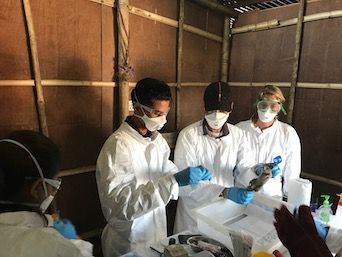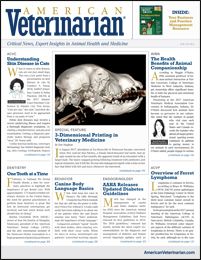PREDICT: A One Health Preventive Effort
Led by the University of California, Davis, One Health Institute, PREDICT is improving global disease recognition through worldwide collaboration.

PREDICT team from the Center for Molecular Dynamics
Nepal samples rodents for potentially zoonotic
viruses inand around people’s homes in Nepal.
The statistics are alarming. Nearly 75% of all new, emerging, or reemerging diseases affecting humans at the beginning of the 21st century are zoonotic, according to the United States Agency for International Development (USAID).1 Zoonotic diseases cause more than 1 billion cases of illness annually.2
Severe acute respiratory syndrome (SARS), HIV/ AIDS, the H5N1 strain of avian influenza, Ebola, and the H1N1 influenza virus are all reminders of how quickly zoonotic viruses can reach pandemic proportions. In the modern world, where people can travel across multiple continents in a matter of hours, there is an emphatic need to monitor pathogens that can cross over from animal hosts to humans. The PREDICT project aims to do just that.
The Project
PREDICT is a venture of USAID’s Emerging Pandemic Threats program, led by the One Health Institute at the University of California, Davis (UC Davis), School of Veterinary Medicine. The project is a worldwide collaboration to detect zoonotic dis-eases at the wildlife—human interface. In the 7 years since it began, PREDICT has worked with more than 30 countries to develop and employ standardized approaches for collecting and sharing data across One Health platforms.
RELATED:
- One Health and Antimicrobial Resistance
- WVC 2017: Who's at Risk for Bartonellosis? A One Health Perspective
“It’s groundbreaking in terms of trying to advance disease detection around the world for emerging pandemic threats,” said Christine Kreuder Johnson, VMD, PhD, a UC Davis professor and epidemiologist who has worked on PREDICT since its initial proposal phase in 2009.
Dr. Kreuder Johnson called the project extremely advantageous for strengthening the capacity to tackle diseases that emerge from wild animals and identifying potential threats to both animals and humans. In addition, PREDICT uses a multidisciplinary approach to identify specific populations at highest risk of exposure.
To date, PREDICT has trained 3300 government personnel, physicians, veterinarians, resource managers, laboratory technicians, and students in One Health skills, including disease outbreak investigation and biosafety. Project participants also have sampled more than 74,000 individuals, livestock, and wildlife deemed at risk of infection with pathogens with viral spillover.
Specific activities facilitated by PREDICT include:
- Monitoring wildlife and people in contact with wildlife for novel pathogens that may pose a significant public health threat
- Characterizing human and ecologic drivers of disease spillover from animals to people
- Optimizing models for predicting disease emergence and using this information to improve surveillance
- Supporting outbreak response when requested
PREDICT’s ultimate goal is to uncover viruses with potential for zoonotic outbreaks before they become pandemic, with an underscored need to pay close attention to regions deemed hot spots, such as central and west Africa, and south and southeast Asia. The expectation is that learning about these viruses will help governments design policies to better prevent outbreaks.
Four Focus Areas
“Currently, We are very concerned about potentially zoonotic viruses and how they are evolving,” Dr. Kreuder Johnson said. Together with a consortium of partners, including the Wildlife Conservation Society, the EcoHealth Alliance, Metabiota, and the Smithsonian Institution, PREDICT focuses on cross-species disease detection including humans, domesticated animals, and live-stock. “PREDICT is really making major steps forward in trying to look for viruses that could be shared with humans by bats, rodents, primates, or other species where we have special expertise,” she said. “Before PREDICT, there was not a lot of standardized effort to look across species lines for viral threats.”
Dr. Kreuder Johnson—who, when we caught up with her, was en route to a meeting in Brussels, Belgium, attended by more than 120 worldwide experts working on PREDICT—explained that there is an emphasis on detecting coronaviruses, which include Middle East respiratory syndrome and SARS. “We’re looking for coronaviruses in camels and bats, as well as primates and rodents,” she said.
Additionally, she said, PREDICT is overseeing a large effort in West Africa to uncover filoviruses—such as Ebola and Marburg—in bats. “People have looked for filoviruses in different species but have had fairly small sample sizes. PREDICT is making a huge effort to get a lot of samples from many bat species all over west Africa, especially in the 3 post-2014 Ebola outbreak countries: Sierra Leone, Guinea, and Liberia,” she said.
The fourth area of particular interest for the group is detecting influenza virus and new paramyxoviruses, which tend to cross species boundaries quickly. “We’re finding quite a number of [paramyxoviruses], as well as unexpected [carrier] species, like rodent and shrew species, that are living in close contact with humans,” Dr. Kreuder Johnson said.
Looking to the Future
PREDICT is slated to conclude in 2019—the project is broken into two 5-year projects—but Dr. Kreuder Johnson stressed the importance of continued global efforts. “Our collective goal is for the techniques and the technologies to be completely transferred to the communities that we’ve been working with,” she said. “There’s no question that the wildlife surveillance, as well as the human surveillance, need to continue. PREDICT has strengthened the capacity of and built networks around fieldwork for wildlife, as well as for human syndrome surveillance in clinics and hospitals where people would go if they present with acute viral illnesses.”
From a technologic standpoint, PREDICT has made remarkable strides in strengthening communication across the animal health, human health, and wildlife sectors by developing consistent networks for data sharing and platforms for reporting. “I think we’re all interested in continuing to partner with USAID or other entities where our expertise is needed to ensure the latest advances and cutting-edge technologies are infused where that makes sense for this kind of work,” Dr. Kreuder Johnson said.
